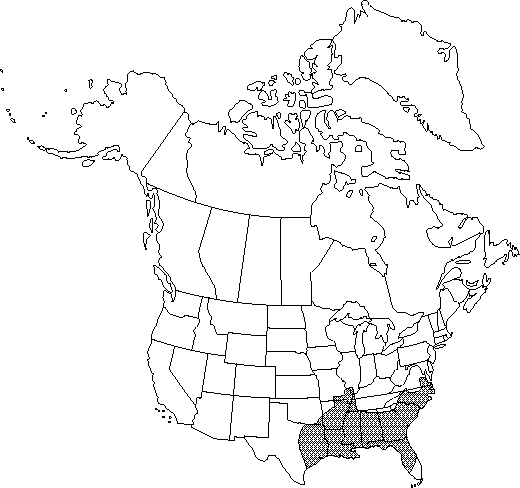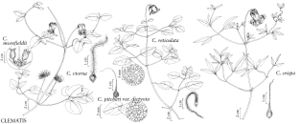Clematis crispa
Sp. Pl. 1: 543. 1753.
Stems viny, to 3 m, glabrous or sparsely to moderately pilose-pubescent, denser at nodes. Leaf blade 1-2-pinnate or rarely a few simple or 3-foliolate; leaflets 4-10 plus additional ± tendril-like terminal leaflet, usually lanceolate to ovate, occasionally linear, unlobed or proximally 3-5-lobed, (1.5-)3-10 × (0.1-)0.4-4(-5) cm, thin, not conspicuously reticulate; surfaces glabrous, not glaucous. Inflorescences terminal, 1-flowered; bracts absent. Flowers bell-shaped; sepals distally strongly spreading to recurved, violet-blue, lanceolate, 2.5-5 cm, margins proximally thick and tomentose, distally broadly expanded, 2-6 mm wide, thin, crispate, less conspicuously tomentose than proximal portion, or glabrate, tips acuminate, abaxially glabrous. Achenes: bodies appressed-puberulent; beak 2-3.5 cm, appressed-puberulent. 2n = 16.
Phenology: Flowering spring–summer.
Habitat: Low woods, bottomlands, swamps
Elevation: 0-200 m
Distribution

Ala., Ark., Fla., Ga., Ill., Ky., La., Miss., Mo., N.C., Okla., S.C., Tenn., Tex., Va.
Discussion
Clematis crispa is highly variable in leaflet width, and conspicuous variation may occur on a single plant (R.O. Erickson 1943); no discontinuity or geographic correlation exists that would permit the recognition of varieties. The dilated, petaloid sepal tips and thin, crispate, broadly expanded sepal margins are diagnostic for this species.
Selected References
None.
